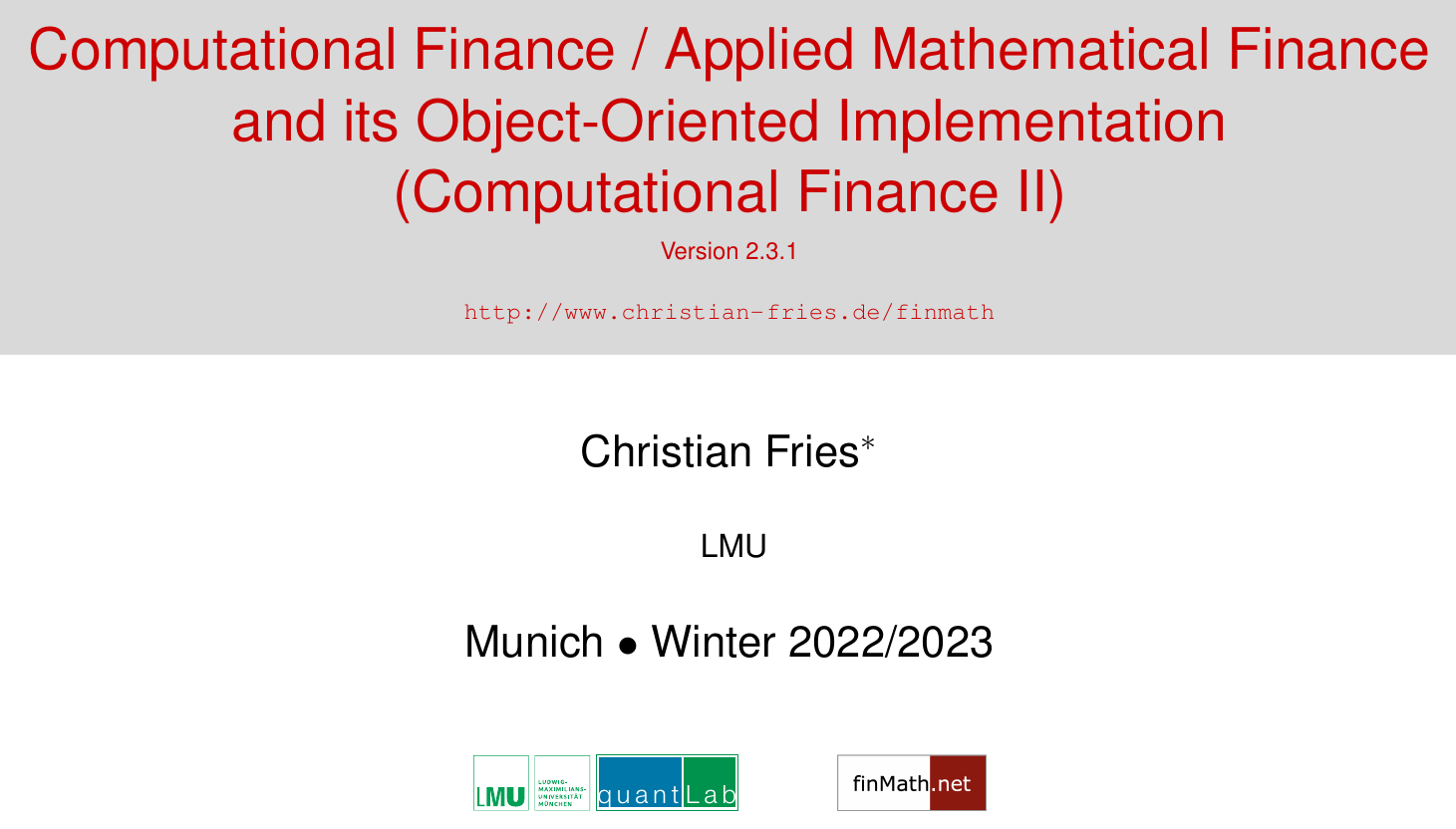- Trainer/in: Ulrich Bauer
- Trainer/in: Thomas Vogel
- Trainer/in: Markus Land
About this Lecture
This lecture discusses the interplay of Theory, Modelling, Numerical Methods and Implementation in Mathematical Finance.
All aspects learn from each other: one needs to understand the theory to build models and good implementations. Studying numerical experiments gives deeper theoretical insight. Using the computer to understand math can be fun!
We discuss how to build an industry-grade implementation of our models and allow future extensions while being efficient. We discuss practical applications in the financial industry.
The lecture tries to be as self-contained as possible, but we will use some numerical methods developed in a previous course. We will start with a short recapitulation of the numerical methods needed for those who did not follow the last lecture. It is possible to consider most of these parts as “given” (“black box”). Don’t panic: We will assist you.
The lecture will discuss the theory and application of some prominent methods and models from mathematical finance. We focus on interest rate and hybrid models with high relevance for the financial industry. In an excursion, we consider a climate model (DICE), extend it and combine it with our interest rate models.
We will then use our implication to gain a deeper understanding of the theoretical properties of the model.
If time permits, we conclude the lecture by discussing running our models in a cloud.
Enrolment Key: ComputationalFinanceWS22

- Trainer/in: Lorenzo Berti
- Trainer/in: Christian Fries
- Trainer/in: Andrea Mazzon
Description
The lecture provides an introduction to stochastic calculus with an emphasis on the mathematical concepts that are later used in the mathematical modelling of financial markets. In the first part of the lecture course the theory of stochastic integration with respect to Brownian motion and Ito processes is developed. Important results such as Girsanov's theorem and the martingale representation theorem are also covered. The first part concludes with a chapter on the existence and uniqueness of strong and weak solutions of stochastic differential equations. The second part of the lecture course gives an introduction to the arbitrage theory of financial markets in continuous time driven by Brownian motion. Key concepts are the absence of arbitrage, market completeness, and the risk neutral pricing and hedging of contingent claims. Particular attention will be given to the the Black-Scholes model and the famous Black-Scholes formula for pricing call and put options.
References
Stochastic calculus:
C. Dellacherie and P. A. Meyer. Probabilities and Potential B: Theory of Martingales. North-Holland, Amsterdam, 1982.
I. Karatzas and S. E. Shreve. Brownian Motion and Stochastic Calculus. Springer, New York, second edition, 1991.
B. Oksendal. Stochastic Differential Equations: An Introduction with Applications. Springer, Berlin, sixth edition, 2003.
Continuous Time Finance:
T. Björk. Arbitrage Theory in Continuous Time. Oxford University Press, New York, third edition, 2009.
I. Karatzas and S. E. Shreve. Methods of Mathematical Finance. Springer, New York, 1998.
B. Oksendal. Stochastic Differential Equations: An Introduction with Applications. Springer, Berlin, sixth edition, 2003.
Registration Key: FiMa2
- Trainer/in: Karl-Wilhelm Georg Bollweg
- Trainer/in: Ari-Pekka Perkkiö
- Trainer/in: Felix-Benedikt Liebrich
- Trainer/in: Niklas Walter
- Trainer/in: Umberto De Ambroggio
- Trainer/in: Tamas Makai
- Trainer/in: Konstantinos Panagiotou
- Trainer/in: Niklas Weber
In dieser Vorlesung wird in die grundlegende Theorie der Vektorräume eingeführt. Zusammen mit der Linearen Algebra II ist diese Vorlesung unverzichtbare Grundlage für nahezu alle weiterführenden Veranstaltungen der Mathematik. Wichtige Themen und Inhalte sind unter anderem: Grundlegende algebraische Strukturen wie Gruppen, Ringe,Körper und Vektorräume, lineare Gleichungssysteme, lineare Abbildungen und der Zusammenhang zu Matrizen, Basis, Dimension und lineare Unabhängikeit, Determinanten und Eigenwerte.

- Trainer/in: Panagiotis Papadopoulos
- Trainer/in: Andreas Rosenschon
- Trainer/in: Simon Weinzierl
- Trainer/in: Thomas Vogel
- Trainer/in: Thomas Vogel
- Trainer/in: Christian Lange
- Trainer/in: Bernhard Leeb
Course Description
- Master students of Financial and Insurance Mathematics or Mathematics.
- Probability theory and foundations of stochastic processes in continuous time.
- SPDE
- Trainer/in: Alexander Kalinin
- Trainer/in: Adalbert Fono
- Trainer/in: Gitta Kutyniok
- Trainer/in: Mariia Seleznova
- Trainer/in: Matthew Dickson
- Trainer/in: Markus Heydenreich
- Trainer/in: Alejandro Caicedo Serrano
- Trainer/in: Sabine Jansen
- Trainer/in: Simon Gritschacher
- Trainer/in: Jonas Stelzig
This class is meant for everyone interested in problem solving, ML or quant finance 🧐💻 If you want to participate feel free to text us via walter@math.lmu.de or weber@math.lmu.de.
For the registration key ask Alice or Bob.
Organization:
Our first meeting will take place on 20th October from 16-18 o'clock in room B132 (Mathematical Institute)
We aim to find a timeslot that fits the most of us. Therefore, there will be a poll/discussion in the first meeting to determine the sweet spot.
Target Group:
- BSc students of (business) mathematics with good knowledge of stochastic and preferably probability theory
- MSc students of (financial) mathematics
Although the class is mainly tailored for mathematics students, all students from quantitative subjects (e.g. physics, computer science, statistics) are very welcomed to join!
Content:
The content of the class can be structured in three pillars:
- Brainteasers and Logic Problems
- Coding Problems
- Useful and Interesting Theory

- Trainer/in: Niklas Walter
- Trainer/in: Niklas Weber